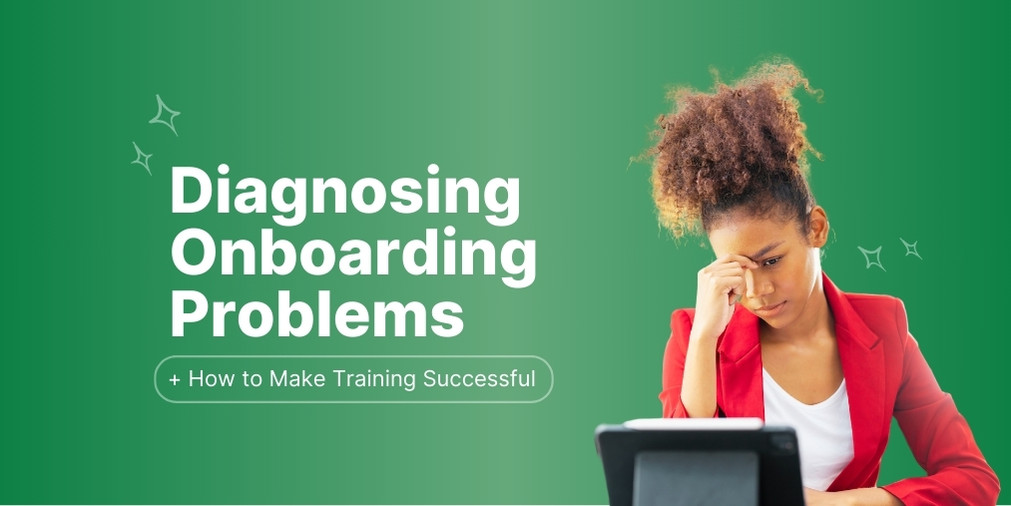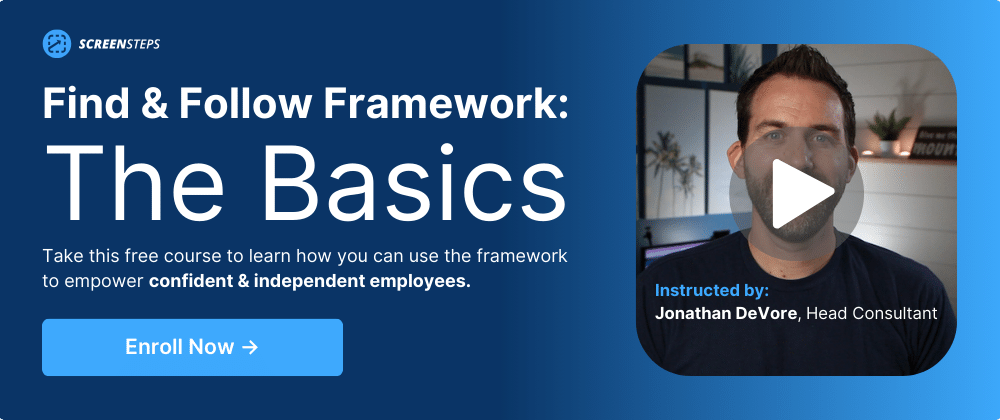Why Your Onboarding Program is Failing (+ How to Make Training Successful)
Is your onboarding curriculum “not working”?
Traditional employee onboarding programs include long lectures, PowerPoint presentations, shadowing, and one-on-one coaching.
Unfortunately, the reality is that some of these traditional training strategies create a painful learning experience for your employees. And no one wants a painful onboarding experience.
Those techniques aren’t necessarily bad, so it can be confusing when those approaches aren’t working. So, why does it feel like your onboarding program is failing?
Working for ScreenSteps — a knowledge ops solution — I’ve seen many accomplished companies struggle with onboarding. And those struggles can disappear if they switch their onboarding approach.
This blog post will help you diagnose the reason(s) your new hire onboarding and training programs aren’t working. Then you’ll learn how you can create a knowledge transfer strategy to improve your onboarding program.
Table of Contents
How can you tell if your onboarding program is a painful experience?

How can you tell if your onboarding program is a painful experience for new hires?
Typically, businesses that express concerns that their “onboarding isn’t working” have one or more of the following situations.
1. Onboarding takes too long
How long does your new hire training take? Is it weeks? Or even months?
When new hires spend weeks or months in the classroom, they get antsy, bored, and disassociate with the lessons. New hires feel useless in a long training program. It isn’t a pleasant experience.
Plus, the longer the training program the more new hires learn without doing, which makes it more difficult for new hires to remember everything once they finish training. The more employees learn before they enter the field, the lower their confidence when they leave training.
2. New hires leave training not able to DO anything
What can new hires do immediately after leaving training? If the answer is “more training” or “shadowing,” then you’re extending that painful training experience.
New hires have passed your quizzes but they have no transferable skills from your training program. Essentially, they have to be “re-trained” on the job. It’s almost as though your weeks- or months-long training program was an appetizer to where the real learning happens.
While employees always want to progress and learn, they don’t want to live in a never-ending training loop. It makes them dependent on the system. It lowers their confidence.
3. New hires quit during onboarding
What percentage of your hiring class quits during onboarding?
If you have a large percentage of new hires quitting before training is over, that is a red flag that the training experience is painful. New hires who feel like they are progressing and who gain confidence through their training don’t quit.
When new hires quit during onboarding, that is a sunk cost. You wasted all the recruiting and onboarding money that you spent to acquire those new hires.
4. New hires are stressed out
Yes, stress happens on the job. However, your new hires shouldn’t be overly anxious on the job.
We’ve talked to companies where new hires were physically ill to go out on their own after training because they were afraid of making mistakes. The thought of doing the job makes them incredibly anxious.
If employees are constantly stressed and anxious on the job, they will eventually leave for a less stressful position.
The challenge with solving these problems
The challenge with solving these problems is that some of our typical solutions exasperate another problem. So as you solve for one, it exposes another issue.
The chart below shows the common pain points of training listed in the section above. The second column shows the common approaches to solving these problems. The third column explains what typically happens as a result of this approach.
How does solving for one exasperate the others? Let’s use the third problem, “new hires quit during onboarding,” as an example.
When you want your new hires to make it to the end of training, your instincts may be to make training less stressful. That could look like decreasing the amount of time in training, removing quizzes, or making training more relaxed.
The consequence is that your new hires will leave training less prepared. They won’t be able to do as much when they leave training. Your new hires will be more stressed out on their jobs because they feel inadequate.
So, how do you stop this revolving circle of problems if solving one problem yields another?
You need to solve the root problem.
What is the ROOT cause of these painful learning experiences?
If you can identify the root cause of these learning problems, you can solve the full problem. So, what is the root cause of these challenges?
The true root cause is that your company is relying on tribal knowledge.
Tribal knowledge is where you depend on word of mouth to share knowledge.
Employees don’t have the training and resources to help them become experts so they rely on asking supervisors or neighbors to get the answers they need.
How to solve those employee training problems
To combat a business culture that relies on tribal knowledge, you need a knowledge transfer strategy.
Your knowledge transfer strategy helps you create a plan that allows you to optimally train, support, and share information with your employees so that they can become experts at their jobs.
When you develop a knowledge transfer strategy for your business, you’ll need to include these three phases.
1. Define and align your knowledge and teams
Often, what happens with employee training curriculums is the person you have training doesn’t actually do the job they are training for. And yet, the trainer develops the employee training curriculum.
The result? Employees leave training with a bunch of knowledge but they don’t know how to do the job.
That’s why the first step in developing a knowledge transfer strategy is two-fold:
- Align your training and operations teams
- Define what you need your new hires to KNOW and what you need them to be able to DO
That means trainers collaborate with supervisors to discuss what new hires in a specific role need to know and what tasks they will be expected to handle. The goal is to align your teams and agree upon what new hires need to know and do to be successful in their jobs
Create a list of this collection of knowledge and tasks. You’ll use this later.
The Find & Follow Workshop
At ScreenSteps, we have our customers run a Find & Follow Workshop before launching their knowledge base and training curriculum. Learn more about how to run a Find & Follow Workshop here.
2. Separate foundational and actionable knowledge
Use the list of tasks and knowledge to separate foundational and actionable knowledge.
 Foundational knowledge is background or contextual information that new hires need to know to handle tasks. This is knowledge employees need to learn or memorize.
Foundational knowledge is background or contextual information that new hires need to know to handle tasks. This is knowledge employees need to learn or memorize.
Actionable knowledge is operational or procedural knowledge. This is knowledge that enables employees to do something. It draws on foundational knowledge to accomplish this.
You will use different approaches to transfer foundational and actionable knowledge.
Download this free workbook to organize your different types of knowledge.
3. Determine the optimal way to transfer different pieces of information
Create a plan on how you will transfer your foundational and actionable knowledge. There are many different ways to do this.
Here are some approaches for each:
Foundational Knowledge
- PowerPoints or slide decks
- eLearning courses or on-demand video courses
- One-on-one conversations
Actionable Knowledge
- Digital guides (i.e. how-to guides, reference articles, checklists, etc.)
- Role-playing
- Scenario-based training
- Hands-on learning experiences
Note: It is HOW you pair these different knowledge transfer techniques that make your knowledge transfer strategy successful.
Build your knowledge transfer strategy with a step-by-step program
When you have a clear knowledge transfer strategy, you improve your onboarding program, which better prepares your new hires for their jobs.
The above three steps for creating a knowledge transfer strategy are part of the Find & Follow Framework. The Find & Follow Framework is a clear knowledge transfer strategy that helps companies transfer knowledge faster while building more confident and independent employees.
ScreenSteps developed the Find & Follow Framework to help organizations improve knowledge operations in their businesses. With Find & Follow, companies have been able to drop their time to proficiency by 75%. One company reduced training time from 12 months to one month.
Think Find & Follow could help your company?
Learn more about the Find & Follow Framework with a free 30-minute course here. The course walks through the different steps of the methodology.




